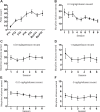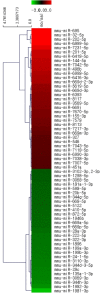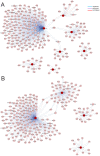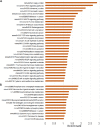Intravenous morphine self-administration alters accumbal microRNA profiles in the mouse brain
- PMID: 29451210
- PMCID: PMC5840996
- DOI: 10.4103/1673-5374.224374
Intravenous morphine self-administration alters accumbal microRNA profiles in the mouse brain
Abstract
A significant amount of evidence indicates that microRNAs (miRNAs) play an important role in drug addiction. The nucleus accumbens (NAc) is a critical part of the brain's reward circuit and is involved in a variety of psychiatric disorders, including depression, anxiety, and drug addiction. However, few studies have examined the expression of miRNAs and their functional roles in the NAc under conditions of morphine addiction. In this study, mice were intravenously infused with morphine (0.01, 0.03, 0.3, 1 and 3 mg/kg/infusion) and showed inverted U-shaped response. After morphine self-administration, NAc was used to analyze the functional networks of altered miRNAs and their putative target mRNAs in the NAc following intravenous self-administration of morphine. We utilized several bioinformatics tools, including Kyoto Encyclopedia of Genes and Genomes (KEGG) pathway mapping and CyTargetLinker. We found that 62 miRNAs were altered and exhibited differential expression patterns. The putative targets were related to diverse regulatory functions, such as neurogenesis, neurodegeneration, and synaptic plasticity, as well as the pharmacological effects of morphine (receptor internalization/endocytosis). The present findings provide novel insights into the regulatory mechanisms of accumbal molecules under conditions of morphine addiction and identify several novel biomarkers associated with morphine addiction.
Keywords: bioinformatics; microRNA; morphine; nerve regeneration; neural regeneration; nucleus accumbens; self-administration.
Conflict of interest statement
None declared.
Figures






Similar articles
-
Abstinence from Escalation of Cocaine Intake Changes the microRNA Landscape in the Cortico-Accumbal Pathway.Biomedicines. 2023 May 5;11(5):1368. doi: 10.3390/biomedicines11051368. Biomedicines. 2023. PMID: 37239038 Free PMC article.
-
TRPV1 modulates morphine-induced conditioned place preference via p38 MAPK in the nucleus accumbens.Behav Brain Res. 2017 Sep 15;334:26-33. doi: 10.1016/j.bbr.2017.07.017. Epub 2017 Jul 19. Behav Brain Res. 2017. PMID: 28734766
-
Nucleus Accumbens AMPA Receptors Are Necessary for Morphine-Withdrawal-Induced Negative-Affective States in Rats.J Neurosci. 2016 May 25;36(21):5748-62. doi: 10.1523/JNEUROSCI.2875-12.2016. J Neurosci. 2016. PMID: 27225765 Free PMC article.
-
Reflections on: "A general role for adaptations in G-Proteins and the cyclic AMP system in mediating the chronic actions of morphine and cocaine on neuronal function".Brain Res. 2016 Aug 15;1645:71-4. doi: 10.1016/j.brainres.2015.12.039. Epub 2015 Dec 29. Brain Res. 2016. PMID: 26740398 Free PMC article. Review.
-
Localization of brain reinforcement mechanisms: intracranial self-administration and intracranial place-conditioning studies.Behav Brain Res. 1999 Jun;101(2):129-52. doi: 10.1016/s0166-4328(99)00022-4. Behav Brain Res. 1999. PMID: 10372570 Review.
Cited by
-
Negative allosteric modulation of CB1 cannabinoid receptor signalling decreases intravenous morphine self-administration and relapse in mice.Addict Biol. 2024 Aug;29(8):e13429. doi: 10.1111/adb.13429. Addict Biol. 2024. PMID: 39109814 Free PMC article.
-
Noncoding RNA therapeutics for substance use disorder.Adv Drug Alcohol Res. 2022;2:10807. doi: 10.3389/adar.2022.10807. Epub 2022 Dec 20. Adv Drug Alcohol Res. 2022. PMID: 36601439 Free PMC article.
-
Sex-Specific Concordance of Striatal Transcriptional Signatures of Opioid Addiction in Human and Rodent Brains.Biol Psychiatry Glob Open Sci. 2025 Feb 26;5(3):100476. doi: 10.1016/j.bpsgos.2025.100476. eCollection 2025 May. Biol Psychiatry Glob Open Sci. 2025. PMID: 40248277 Free PMC article.
-
miRNAs and Substances Abuse: Clinical and Forensic Pathological Implications: A Systematic Review.Int J Mol Sci. 2023 Dec 4;24(23):17122. doi: 10.3390/ijms242317122. Int J Mol Sci. 2023. PMID: 38069445 Free PMC article.
-
Role of microRNAs in the pathophysiology of addiction.Wiley Interdiscip Rev RNA. 2021 May;12(3):e1637. doi: 10.1002/wrna.1637. Epub 2020 Dec 17. Wiley Interdiscip Rev RNA. 2021. PMID: 33336550 Free PMC article.
References
-
- Cunha-Oliveira T, Rego AC, Oliveira CR. Cellular and molecular mechanisms involved in the neurotoxicity of opioid and psychostimulant drugs. Brain Res Rev. 2008;58:192–208. - PubMed
-
- Dacher M, Nugent FS. Morphine-induced modulation of LTD at GABAergic synapses in the ventral tegmental area. Neuropharmacology. 2011;61:1166–1171. - PubMed
LinkOut - more resources
Full Text Sources
Other Literature Sources

